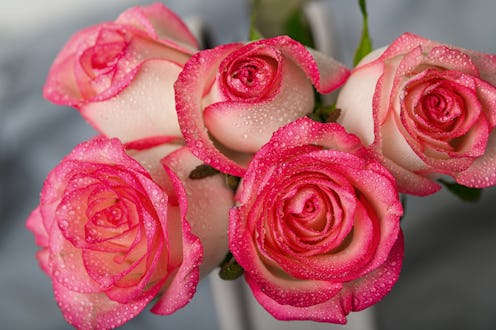
I spend a lot of time making beauty products. While some would consider making rose water a waste of time, I tend to agree with what Antoine de Saint-Exupery said in The Little Prince: "It is the time you have wasted for your rose that makes your rose so important." The process of making rose beauty products varies and it can be overwhelming to determine which rose product to use for what. Whether it's rose water, rose oil, or rose petals, you can rest assured that all your rosy beauty products have uplifting properties for your skin just like they do for your heart.
Roses are incredibly versatile; they can help heal oily and dry skin by having both cleansing and moisturizing properties. According to sources at Organic Authority, the antibacterial properties of roses can benefit acne prone skin as well. While roses have been popular in the fragrance world for almost ever, they are just now growing in popularity in skincare. Whenever I see a natural ingredient on a skin or hair care product, my first thought is how can I make this myself? That's why I decided to do a little detective work and determine how to produce basically every type of rose product on my own.
Here's a little Rose 101 for anyone looking to DIY their way into one of the most romantic (and more importantly gothiest) ingredients in beauty while maintaining the effectiveness in each and every petal.
1. Rose Water
Rose water is made from steeping roses in water. According to Refinery29, rose water has naturally antiseptic, anti-inflammatory, and antibacterial properties. My love of rose water runs deep, since I can use rose water solo and easily make it on my own. Rose water is great as a no-poo treatment for your hair, as a toner your face, and as a gentle cleanser for sensitive skin. I use rose water when my skin feels slightly dry and needs to replenish, or I'll add a pinch of oil and witch hazel to use it as a makeup remover.
2. Rose Absolute Oil
Rose absolute is commonly made from solvent extraction and, according to sources at Aroma Web, this process can lead to residual solvents being left in the rose oil. According to sources at Aura Cacia, absolute oil is derived using alcohol which is removed through evaporation. Basically, rose absolute is a concentration of aromatic compounds. Because of the extraction process of rose absolute, I like to use it to add fragrance to my DIY daily perfume rather than my skincare products. You know, juuuuust in case there are any traces of chemicals or alcohol that could disturb my already temperamental skin and hair.
3. Rose Otto Oil
In the same article from Aura Cacia, it's stated that it takes over two dozen roses to make one drop of rose oil. The oil is made in a two part steam distillation process from newly opened roses. Due to the purity of the roses, the price of pure rose otto oil is usually around $100, so I love using it for special occasions. I like to add drops of rose otto to a French Clay mask or a night serum with baobab oil. The fragrance of rose otto is a little spicier and a little grimier than rose water or absolute oil, with the familiar scent of roses hiding in the background. It's kind of my jam right now.
4. Dried Rose Petals
One of the only ways I've been able to actually get my blush the right color for my skin was by blending dried rose petals into a mixture of arrowroot and cocoa powder. As a bonus, the leftover petals make for excellent potpourri.
5. Fresh Rose Petals
All of the nutrients that make rose great are derived from the precious petals. So, instead of boiling down your roses or attempting to extract oil on your own, you can sprinkle fresh rose petals right into your. While you bask in the beautiful scenery, relax, take a selfie, and know your skin is drinking up those pricey unique nutrients.
Want more beauty tips? Check out the video below and subscribe to Bustle on YouTube!
Images: Senko Nelly/Moment/Getty Images; Kristin Collins Jackson (6)